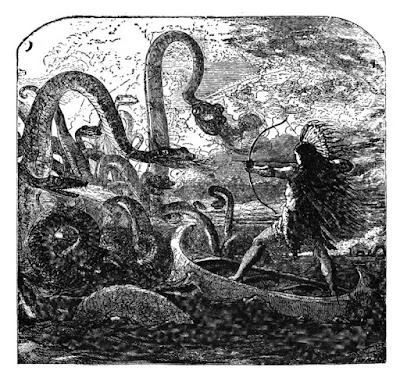Week 10 Reading Notes: Song of Hiawatha B
Today we continue the Song of Hiawatha, the story of a legendary hero in Native American mythology. Overall, I found the story to be incredibly interesting and unique in comparison to "Old World" stories, featuring a deeper connection to nature and divinity than is expressed in most of the Western canon. Hiawatha himself originates many things, including the development of corn, where a woodpecker gets it red color, and more, and also shows himself to be the mighty warrior of legend in these tales.
This week's specific story of interest was an easy choice. Continuing my love of heroism once again, we see Hiawatha defeat the evil sorcerer Pearl Feather, who had slain in vain the father of one of his own. Hiawatha prepares intricately, and sails to the home of Pearl Feather through the rot waters, past the fire serpents (which he kills with ease), to his evil grounds. Therein, he fights a losing battle against a seemingly invincible enemy, fighting until his strength begins to falter. As he leans against a tree in hiding, a woodpecker delivers to him the secret to slaying the evil magician: hit the top of his head. He finally slays the man, and decorates the woodpecker in red blood of the man as a decoration of triumph.
This tale is an excellent showing of defeating a seemingly impossible enemy through a deus ex machina of nature, finding a critical weakness at the most opportune moment. While this tale may seem generic at the front, many Western tales usually offer divine intervention, as opposed to Hiawatha's saving by nature.
I hope to try to integrate many of the nature tales in my story this week, perhaps in the survival of a people striving against nature itself.
Once again, I mostly avoided the romance tale for my discussion this week.
Bibliography: The Song of Hiawatha. Untextbook Link
 |
| Hiawatha slays the serpents |
This week's specific story of interest was an easy choice. Continuing my love of heroism once again, we see Hiawatha defeat the evil sorcerer Pearl Feather, who had slain in vain the father of one of his own. Hiawatha prepares intricately, and sails to the home of Pearl Feather through the rot waters, past the fire serpents (which he kills with ease), to his evil grounds. Therein, he fights a losing battle against a seemingly invincible enemy, fighting until his strength begins to falter. As he leans against a tree in hiding, a woodpecker delivers to him the secret to slaying the evil magician: hit the top of his head. He finally slays the man, and decorates the woodpecker in red blood of the man as a decoration of triumph.
This tale is an excellent showing of defeating a seemingly impossible enemy through a deus ex machina of nature, finding a critical weakness at the most opportune moment. While this tale may seem generic at the front, many Western tales usually offer divine intervention, as opposed to Hiawatha's saving by nature.
I hope to try to integrate many of the nature tales in my story this week, perhaps in the survival of a people striving against nature itself.
Once again, I mostly avoided the romance tale for my discussion this week.
Bibliography: The Song of Hiawatha. Untextbook Link



Comments
Post a Comment